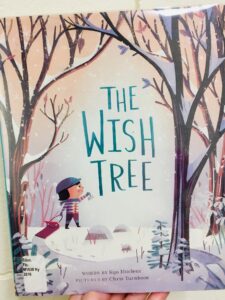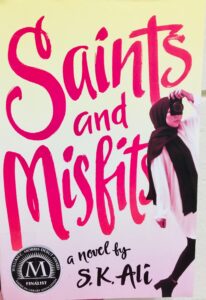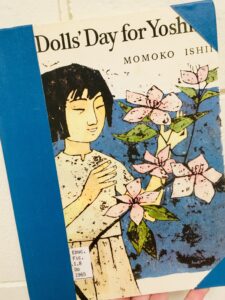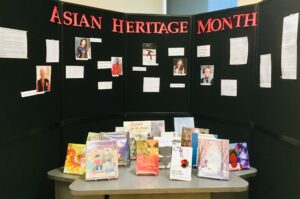Shelby Kirilenko was a student in INTS 380: Internship in Library and Information Studies, which is offered in the winter term by the University Library for students in the College of Arts & Science. Shelby completed a three-month internship with Maha Kumaran, Head, Education & Music Library. Staff at the Education & Music Library branch collaborated on creating the interview questions below. The interview questions and Shelby’s responses provide us with an understanding of the intern’s perspective of the program, librarianship, and our library.
Tell us about your experience in the Library internship program.
I joined the Library Internship Program to learn more about the ever-changing field of academic librarianship. My experience was excellent. There’s a class portion and an internship with a librarian. The class is completed over one semester for three credits. I met with Maha Kumaran, Head Education & Music Library, almost every Monday and Friday from January 2019 to the beginning of April 2019. I learned about ethnic diversity in librarianship. I also learned about copyright issues, ordering materials and processing library materials, cataloguing, and various collections including the Aboriginal education collection, historical texts, and the young adult collections. I also visited the Murray Library and learned about other resources such as the Indigenous Studies Portal (iPortal). It was somewhat difficult to try and fit 70 hours of interning over the course of one semester, but it was very rewarding.
What did you find different or surprising about the field of librarianship?
The most surprising thing I learned about librarianship is the number of different paths to practice librarianship. From cataloguing to subject librarians, in public or academic libraries, there are many different paths and career choices with room for everyone, no matter how varied their library interests may be.
How did this program prepare you to organize information for the Asian Heritage display?
After consultations with Maha, based on my interests, and timeliness of the internship which ended in April, I chose to work on the Asian Heritage display. I was able to find resources by learning how to search and find materials through the catalogue and the various relevant research guides. The program also helped me by teaching me how to choose items based on audience levels (children and young adults were my focus). Maha also directed me towards young adult book award websites and the Young Adult Library Services website (YALSA), which were very helpful.
To determine materials for the Asian Heritage display, I thought about what would be most informative to the audience who visit this display. I chose books with a focus on: Asian characters; Asian authors; the history of Asian Canadians; or books set in an Asian country. I posted information about what Asian Heritage month is, as well as Canadian associations involved. I also wanted the display to be eye-catching, so I used pictures and added short informative paragraphs about them. For the pictures, I chose a mix of Asian Canadians that users may or may not recognize as Canadians, and therefore may not be aware of their contributions to Canada. I added a blurb about each person and their contributions under their picture.
Was it easy to find materials for this display? If yes or no, why/why not? Or tell us how you think the library can make it easier.
It was fairly easy to find books through word and author searches, however, I think searching by subject headings could be improved further. It takes a lot of time to understand how to search library resources and to apply appropriate limits to find what one needs. I found materials using the subject search, but I am not confident that the subject headings are a comprehensive list. To search for specific subjects, sometimes I had to try three different variations of the subject to find what I needed. If I searched the subject “Asia – Juvenile Fiction,” I could only find one result. If I searched for “Chinese Canada — Fiction,” the juvenile fiction results would not be displayed. However, if I was more specific and searched for the subject “Chinese Canada — Juvenile Fiction,” I found what I needed. This means one has to know and search for each country in Asia in the catalogue, and try it with other key subjects, like “Juvenile fiction” or “History”, to get specific results. From here on I could apply location (Education & Music Library) and material format limits (e.g., books, journals, audio-visual) and access what I needed for the display. Since materials are catalogued in many different ways, it can be hard to find what you need unless you know the specific title or author, or have a good knowledge of subject headings.
What did you learn while looking for materials to pull for this display?
I learned that how I search really matters. For example, if I am searching for Chinese New Year, I can use keywords such as “Chinese Festivals”, or “Chinese Celebrations” both of which produce different sets of results with some overlap. One can also use “China –Festivals” as a subject heading. I learned the importance of searching several resources in multiple ways to retrieve everything I needed.
I also learned how to search Sierra, the integrated relational database, which is the behind the scenes library catalogue. By using this database, I was able to find items in a way that front-end users cannot. For example, I can look at the bibliographic and item records of a book to help locate a book that is not on the shelf. The record will show the last check-in date, so I can learn when and where the book was last checked in. In the Sierra item records, I could edit the status of an item (from “In library” to “on Exhibit”). Notes that are not displayed in the public catalogue can be added to the item record using Sierra, to provide additional location information. (e.g. items on display).
As a library user, what is your take away from this experience?
I have two main takeaways from this experience: 1. Usearch is not is the most effective tool in finding and accessing materials I need. So, I recommend the use of catalogues and research guides! 2. Do not take library staff for granted. Everyone in the library does a lot of work in the back end, to facilitate end-user access and to help serve its users. To this I am thankful.
If you have any questions or comments, send an email to maha.kumaran@usask.ca






Thanks for the wonderful interview! It’s great to learn more about the experiences and takeaways of our library interns. I appreciate that she highlighted the behind-the-scenes work of our staff and the importance of robust library metadata and discovery systems!